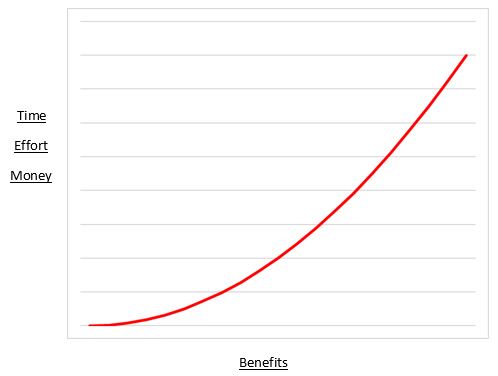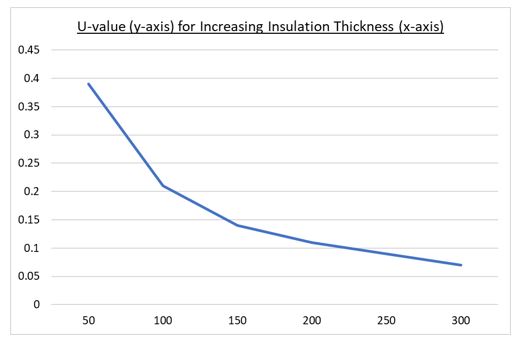Many things in life are governed by a law of diminishing returns. Transforming yourself from a couch potato to a good amateur runner might take 5 hours a week, but getting from amateur to Olympian probably takes another 35.
The same law is true when it comes to achieving energy efficiency in construction.
How Easy is it to Improve the Energy Efficiency of a Typical Building?
Reducing a building’s energy consumption by 50% is often relatively straightforward (depending on the starting point) . You could upgrade the windows and doors, insulate the loft floor or plug obvious drafts, for example.
Reducing consumption by 80% is challenging but achievable, but reducing by 95% is near impossible; seriously disruptive measures would be needed in a retrofit scenario. Any energy efficiency improvements use up time, cause compromise, and cost money.
So where should we be aiming on this scale of effort versus reduced carbon emissions?

Before we try and answer that question it’s useful to think about some real-life examples. As one of the few regularly quantified metrics in the industry, the airtightness of the building fabric illustrates the point nicely.
The airtightness of a new-build home in the UK must legally be 10 m3/m2hr or better during a 50Pa pressure test. If a house is weathertight, it will probably hit this extremely low bar.
A little bit of attention to detail, some expanding foam and foil tape, and you might reasonably expect to get to 6 m3/m2hr @50Pa. A diligent builder, some proprietary airtightness products, tapes around window frames with membranes here and there, and you could get to 3 m3/m2hr @50Pa.
But, if you want to go further, for example by hitting the Passivhaus target of 0.6 ach (similar to 0.6 m3/m2hr @50Pa in this context), it takes extensive detailing during the design stage, a dedicated and absolutely continuous airtightness layer throughout the building envelope, and a number of diagnostic air tests during construction to identify and rectify issues.
A similar pattern emerges when it comes to insulation. A cavity wall insulated with 100mm of PIR (not a great idea) has a U-value of around 0.21 W/m2K. Increasing the insulation thickness to 150mm achieves a U-value of 0.14 W/m2K, an improvement of 0.07 W/m2K. However, another 50mm insulation increase, to a total of 200mm, gets to a U-value of 0.11 W/m2K, an improvement of just 0.03 W/m2K. This trend continues, with reduced thermal benefit as thickness increases.

You can see why large-scale developers, driven by their bottom line, often end up applying a “light touch” when it comes to energy efficiency.
Is it Worth Paying More for More Insulation?
Why pay for that third and fourth 50mm of insulation when most of the benefit comes from the first and second? As it happens, there are some compelling arguments that justify shelling out for sustainability if you are driven by more than short term profit.
Carbon Lock-In for Buildings is Important
This term is also used in areas other than construction, and describes the impact of choosing a carbon intensive, or more carbon intensive, strategy that becomes difficult or costly to change. Selecting a better approach in the first instance ends up being far superior, often for a relatively small short-term cost uplift.
This applies particularly to the construction industry because buildings last for so long. The approach we choose now will have ramifications for 50 or 100 years, so it’s the optimum solution over that period that should be prioritised.
Returning to one of our previous examples, using just 100mm of cavity wall insulation seems like a good idea today, but how difficult will it be to upgrade in 20 years’ time? Very difficult, so it’s much better to go for 200mm to start with. Future upgrades often can’t be justified at all, so the high emissions specification is “locked in” indefinitely.
In short, anything other than a long-term view is dangerous.
Today’s Best is Tomorrow’s Normal
Pushing the limits of what’s possible has resulted in some incredible human achievements, and the same drive will be required to overcome self-inflicted climate change. We should all be building to the highest possible sustainability standards. Doing this will have an impact beyond the boundaries of an individual project, as sustainable technology and design practice transitions from exceptional to “business as usual”.
In any industry early adopters are essential for progress. Low energy building in the UK is no exception, and it’s everyone’s responsibility to do their bit. The more an exemplar standard like Passivhaus is adopted, the cheaper the skills and materials required will become.
Health and Comfort
Low-energy buildings are all about reducing carbon emissions and saving the planet. That is the priority, but insulation, airtightness and efficient building services bring much more to the party.
Improved indoor air quality and temperature control have numerous health benefits. It goes without saying that a building that’s warm in the winter and cool in the summer is far more comfortable than the leaky, poorly insulated alternative. And last but not least, the quality of workmanship in highly efficient buildings also increases thanks to more demanding airtightness targets and stricter quality assurance processes.
All things considered, our energy efficiency returns don’t look so diminished after all.